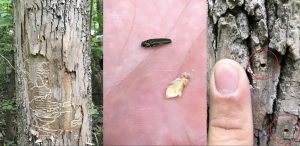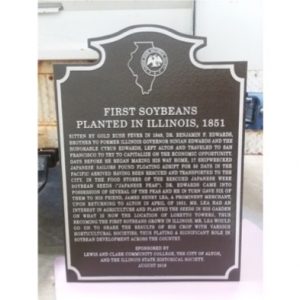Metro East news briefs
August 21, 2019
Emerald ash borer, and exit hole produced in ash trees by larvae
(Photo courtesy of Lewis & Clark Community College)
Local bike path projects awarded state of Illinois grants
Gov. J.B. Pritzker announced $2.6 million in grants for 16 local projects that will help communities acquire, develop and improve bike path facilities throughout Illinois.
Funds for the Bicycle Path Grant Program, administered by Illinois Department of Natural Resources (IDNR), are for the acquisition of land or development of facilities for bicycle paths.
The Bicycle Path Grant Program provides a maximum grant award of $200,000 per application for development projects, with no maximum grant award for acquisition projects.
For this round of grants, a total of 17 applications were received, representing a combined request of $2.7 million. Combined with previous years’ funding, IDNR has awarded grants that have helped develop nearly 1,000 miles of local government bicycle trails in Illinois since 1990.
A list of this year’s Bicycle Path grants, grant recipients, and project information is below:
City of Edwardsville (Madison County) – Illinois 159 Trail – Phase 1, $150,000, to construct 1,100 feet (.210 mile) from intersection of Terra Verda Drive with Illinois Route 159 (Plum Street) north to the intersection of W. Magnolia Street. This trail will connect to the existing shared-use path located along the eastern side of Illinois Route 159.
Village of Godfrey (Madison County) – F.E. Widman Trail, $200,000, to acquire a 1-mile segment of the Fred Widman Bike Trail.
Madison County Transit – Schoolhouse Trail/Pleasant Ridge (Madison County), $185,000, to establish a 300 ft. (.056-mile) trail connection between the 15.5-mile MCT Schoolhouse Trail and the 51-acre Maryville Pleasant Ridge Park.
Madison County Transit – Nickel Plate Trail (Madison County), $200,000, to renovate a 1.2-mile segment of the Nickel Plate Trail beginning at Illinois Route 143 and ending at Peradotti Road.
Madison County Transit – Troy Trail (Madison County), $191,000, to construct a .8-mile trail at Spring Valley Road and west to Formosa Road. This will connect to the MCT Bus Stop and Park and Ride lot (used as trailheads) at South Main Street and the west terminus is at Formosa Road.
Village of Shiloh (St. Clair County) – Air Mobility Drive Trail, $200,000, to construct a 1.25-mile trail beginning at MetroBikeLink (north of Section Line Road) and ending at the Shiloh-Scott Air Force Base Commuter trail along Seibert Road.
St. Clair County Transit District (St. Clair County) – Old Collinsville Road Trail, Phase 2, $200,000, to construct one mile of trail along Old Collinsville Road (Phase 2). This will connect to the Phase 1, from Lebanon Avenue to Rand Lane.
Emergency Telephone Board OKs reimbursing towns
Officials passed a resolution Wednesday approving reimbursements for more than $630,000 to go to Madison County’s 911 call centers.
The Emergency Telephone System Board voted to pay $630,927 in reimbursement costs for the period of Jan. 1 to June 30. In May, the ETSB approved the bi-annual reimbursement rate of $13 per call.
In 2018, Madison County Public Safety Answering Points, PSAPs or 911 call centers, received 119,778 calls. Since Jan. 1, the PSAP’s answered 56,678 calls.
Officials began talking about the reimbursement last year.
ETSB Chairman Robert Rizzi Jr. said since the inception of 911 in Madison County, local municipalities/law enforcement agencies with PSAPs, paid personnel costs and Madison County 911 paid for equipment and training.
There are currently 15 PSAPs, which includes a line at the 911 office. The submitted consolidation plan, which is state mandated, will bring the number to eight.
Rizzi said the reimbursement isn’t a full reimbursement, but what ETSB calculated would cover for 911 calls.
The board determined the reimbursement rate after conducting a study on the average time spent answering 911 calls by a telecommunicator. The reimbursement will be paid from the monies it receives from its 911 emergency telephone surcharge, which is around $3.6 million annually.
The reimbursements to be paid for the number of calls to the municipalities are:
- Alton — 9,183 calls — $119,379
- Bethalto — 1,452 calls — $18,876
- Collinsville — 4,726 —$61,438
- Edwardsville — 3,496 — $45,448
- Glen Carbon — 3,514 — $45,682
- Granite City — 8,157 — $106,041
- Highland —1,359 — $17,667
- Madison — 1,906 — $24,778
- Pontoon Beach — 1,768 — $22,984
- Troy — 1,795 — $23,335
- Venice — 491— $6,383
- Wood River— 5,173— $67,249
- Madison County Sheriff’s Department — 13,203 — $65,672, which is $105,887 less for position currently funded
- Southern Illinois University Edwardsville — 455 — $5,915
The County Board will vote Aug. 21 on the reimbursement rates.
Invasive insect species threatens area trees
A fast-spreading invasive insect species — now found in Metro East — poses a serious threat one of the area’s most popular trees, according to Lewis and Clark Community College’s National Great Rivers Research and Education Center (NGRREC).

Plague marking site of Illinois’ first soybean planting
(Photo courtesy of Lewis & Clark Community College)
Researchers and the U.S. Army Corps of Engineers (USACE) are meeting this week on strategy to combat the emerald ash borer in Southwestern Illinois.
“Emerald ash borer is a forest pest, found throughout the eastern U.S., but was recently detected in the Riverbend area on USACE Rivers Project property,” said USACE Biologist Brian Stoff, who will present the seminar. “With green ash being one of the most abundant tree species in the Mississippi River floodplain, the USACE foresters and biologists are working to determine the best course of action.”
The emerald ash borer (EAB), is an exotic beetle, native to Asia, that was first discovered in the U.S., in southeastern Michigan, near Detroit, during the summer of 2002.
Adult beetles nibble on ash foliage but cause little damage.
However, EAB larvae (beetles in an immature stage) feed on the inner bark of ash trees, disrupting the tree’s ability to transport water and nutrients.
The emerald ash borer probably arrived in the United States on solid wood packing material carried in cargo ships or airplanes.
As of October 2018, it was found in 35 states, and the Canadian provinces of Ontario, Quebec, New Brunswick, Nova Scotia and Manitoba.
Since its discovery in the U.S, the beetle has killed hundreds of millions of ash trees in North America, according to the Ash Borer Information Network, a collation of government agencies and universities formed to disseminate information about the pest.
In the process, it has cost municipalities, property owners, nursery operators and forest products industries hundreds of millions of dollars, the organization says.
It has prompted regulatory agencies, including the U.S. Department of Agriculture, to enforce quarantines and levy fines to prevent potentially infested ash trees, logs or hardwood firewood from moving out of areas where EABs are found.
In Minnesota, officials are concerned that tree loss could be so severe that heavily forested riverside areas could be turned to bogs.
Granite City area seeks natural disaster declaration
Madison County officials are seeking a natural disaster declaration after two bands of heavy rainstorms, Aug. 12-13, dumped up to nine inches of rain on the Granite City area; flooding streets, homes, and businesses.
Homeowners and businesses can report flood damage and request assistance through the United Way’s 2-1-1 telephone number and 211.org website; 24 hours a day, seven days a week.
The American Red Cross and other non-profit organizations will assist with cleanup or other aid at reported flood sites, according to county officials.
Granit City residents are asked not to place flood debris curbside for refuse collection.
Special trash bins have been placed at the Chouteau, Nameoki, and Venice Township Highway Department buildings for disposal, at no cost, of larges items, such as furniture, damaged during the flooding.
However, disposal of tires, appliances, electronics, or household hazardous waste (e.g.: oil, paint, chemicals) is prohibited.
The Chouteau Township building is located at 906 Thorngate Road in Granite City. The Nameoki Township building is at 4250 Highway 162 in Granite City. The Venice Township building is at 910 Madison Ave. in Madison.
Flooding is a recurring problem in the Granite City area, which lies at one of the lowest points in the American Bottoms floodplain.
However, Granite City Mayor Ed Hagnauer blamed last week’s flooding on the Metro East Sanitary District (MESD), which he said has failed to maintain drainage ditches serving the town.
Another factor, Madison County officials acknowledge, was a large, newly installed pump at the Chouteau/Nameoki /Venice pump station, which the U.S. Army Corps of Engineers had not turned on until the second day of the rain.
MESD Executive Director Steve Adler counters that Granite City is responsible for maintaining the ditches in question, adding that the real problem is southern Madison County’s combined sanitary-stormwater sewer system, which impedes waterflow.
The flooding came just after Gov. J.D. Pritzker, on Aug. 9, signed legislation that will effectively remove Adler as MESD executive director, for not living in the district, an appoint Hagnauer to the MESD board.
At the height of the flooding, the Granite City Police Department requested the public not to drive on inundated city streets. The department ceased responding to non-emergency calls; noting patrol cars could no longer traverse flooded roadways.
The police department’s Humvee was used to respond to emergencies.
About a dozen vehicles were stalled in floodwater around the city. Waves caused by vehicles on flooded streets pushed additional water into homes and businesses, the department noted
Some 1,000 homes were affected by high water — many not covered by flood insurance, county officials say. A disaster declaration could bring government assistance.
The rains delayed the opening of Granite City Schools by a week and forced closure of U.S. Steel’s Granite City Works. However, the company emphasized there were no injuries or damage at the plant.
Rains also cause power outages for 3,000 Ameren Illinois customers; mostly in the Collinsville, Caseyville, Edwardsville and state parks areas.
Fairmont Park cancelled its Aug. 13 live racing program and closed its off-track better parlor on both Aug. 12 and 13. The park’s satellite off-track betting facilities in Alton and on Illinois Route 3 remained open.
The Illinois Department of Transportation (IDOT) closed U.S. Highway 50, at Silver Creek, from Reider Road to Belleville Street, just west of Lebanon, overnight, due to water on the pavement.
Illinois Route 160 was closed from Pocahontas Road to Illinois Route 140, due to culvert failure.
In Alton, city officials closed Riverview Drive, just west of Riverview Park, due to cracks in a retaining wall.
Additional flooding was reported on at least one roadway near Greenville.
Further complicating travel across Metro East, IDOT officials, Aug. 12, delayed reopening of southbound Interstate 55/70, between Interstate 270 and Black Lane, after a microsurfacing treatment, applied over the previous weekend, failed to cure properly.
One southbound lane reopened just before 5 a.m. the following day; but a detour remains in place. The department has not indicated why the treatment, applied by Micro-Surfacing Contractors, Inc. of St. Louis, failed to cure.
Alton to commemorate first soybeans planted in Illinois
Lewis and Clark Community College (LCCC), the City of Alton, and the Illinois State Historical Society promise to reveal little-known history, this Friday, during the dedication of an official state marker on the site where soybeans were first planted in Illinois, back in April 1851.
The introduction of soybeans — today one of Illinois’ most important cash crops — is a surprisingly complex tale, according to LCCC President Dale Chapman.
It involves the 1849 Gold Rush, an Alton medical doctor, 17 shipwrecked Japanese sailors who were rescued after 50 days adrift in the Pacific, and an unbroken chain of custody of Japanese Peas that made their way back to Alton, to become the first soybeans grown in Illinois.
Illinois is today the number one soybean producing state, a title it has held now for five straight years, according to the Illinois Soybean Association. Prairie State farmers produced some 611.9 million bushels of soybeans in 2017. The bean rank second only to corn as the state’s top crop, according to U.S. Department of Agriculture data.
The commemorative event is set for Friday, Aug. 23, at 2 p.m. at 417 Prospect St., in Alton. It is free and open to the public. However, reservations in advance are recommended. Contact LCCC Executive Secretary Sue Keener at skeener@lc.edu or 618-468-2001.
Madison County recognizes river flood responders
Madison County will formally thank government entities and nonprofits that responded to, or worked to prevent, spring Mississippi River flooding, according to County Board Chairman Kurt Prenzler.
A special ceremony is set for 3 p.m., Wednesday, Aug. 21, at the Madison County Administration Building, 157 N. Main St., Edwardsville.
“The support and partnership between all involved decreased the flood threats and prevented a real disaster. This flood was the second highest on record and it cost county municipalities and agencies in Madison County more than $24.8 million to fight,”Prenzler said.
Among those receiving recognition: the U.S. Army Corps of Engineers, Southwest Illinois Flood Prevention District, Illinois National Guard, Metro East Sanitary District, Wood River Drainage and Levee District, City of Alton, City of Wood River, Village of Godfrey, Village of Hartford, Village of East Alton, City of Granite City, City of Madison, City of Venice, Madison County’s Sheriff Department, Highway Department and Emergency Management Agency and Riverbend Family Ministries.







